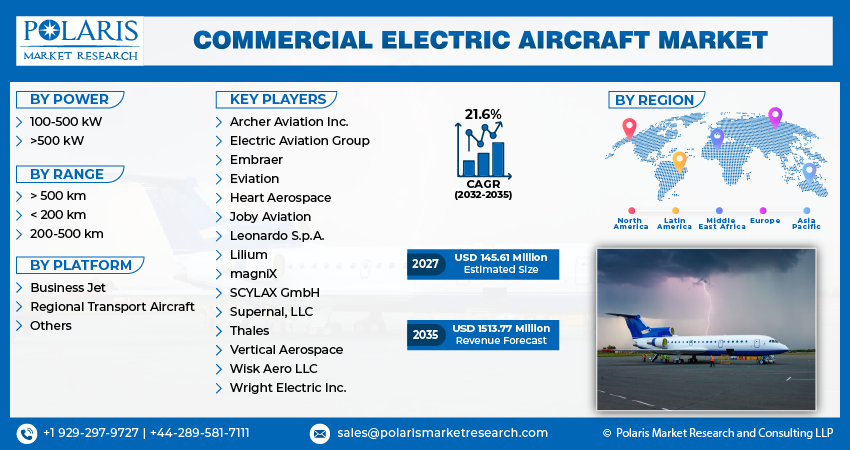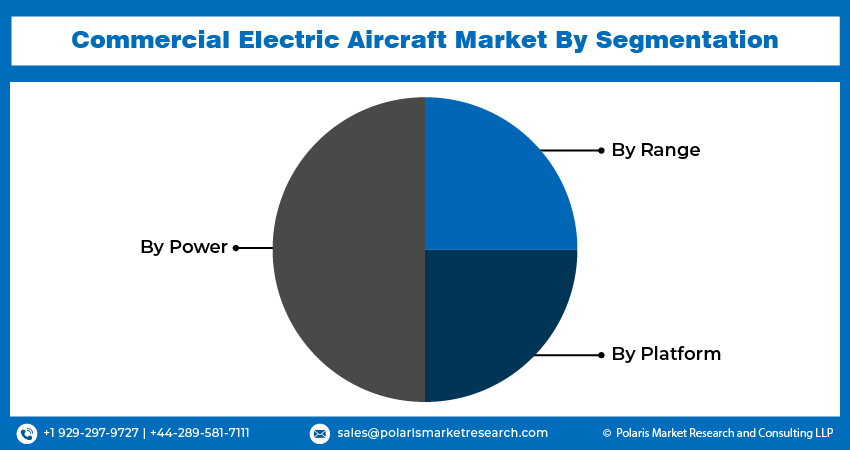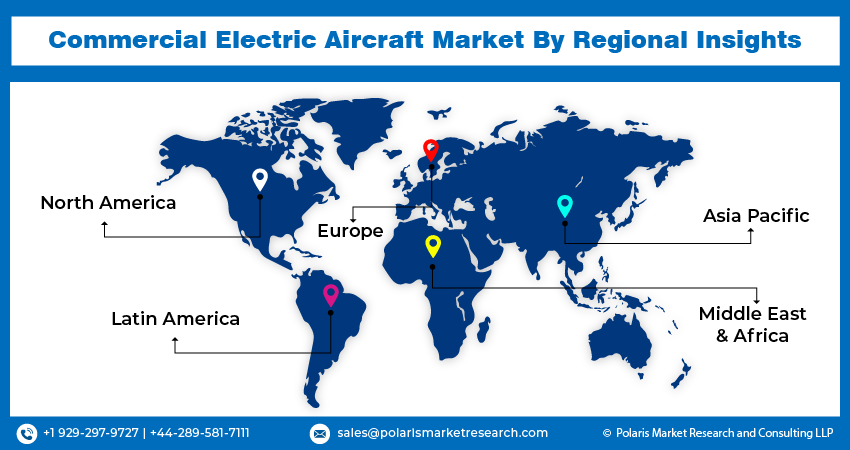
Commercial Electric Aircraft Market Share, Size, Trends, Industry Analysis Report
By Power (100-500 kW and >500 kW); By Range; By Platform; By Region; Segment Forecast, 2032- 2035
- Published Date:Mar-2024
- Pages: 118
- Format: PDF
- Report ID: PM4710
- Base Year: 2032
- Historical Data: 2026-2031
Report Outlook
Commercial Electric Aircraft Market size was estimated valued at USD 145.61 million in 2027 and it is anticipated to value at USD 1,513.77 million by 2035, exhibiting the CAGR of 21.6% from 2032 to 2035.
Commercial Electric Aircraft Market Overview
Commercial electric aircraft are airplanes primarily powered by electric motors, using energy stored in batteries or fuel cells to transport passengers or cargo commercially. This new category of aircraft has the potential to transform the aviation industry by providing a more sustainable and cost-effective alternative to traditional fossil fuel-powered planes. The market demand for commercial electric aircraft is being driven by a growing focus on reducing carbon emissions and addressing climate change, leading to increased interest in cleaner transportation options, including aviation.
- For instance, in October 2023, Garmin agreed to supply BETA Technologies with the Garmin G3000 integrated flight deck for the CX300 electric fixed-wing and A250 electric vertical take-off and landing (eVTOL) aircraft in a long-term partnership. The G3000 boasts high-resolution displays and advanced features for communication, navigation, and surveillance in air traffic management. Its flexible, open, lightweight system architecture is specifically designed to integrate smoothly with BETA's flight battery management, control, and propulsion system.
Moreover, electric aircraft rely solely on electric motors, drawing power from onboard batteries. These aircraft offer advantages such as zero emissions, decreased noise pollution, and lower operating expenses compared to traditional fossil fuel engines. Hybrid aircraft, on the other hand, represent a transitional phase towards fully electric aviation by combining internal combustion engines with electric propulsion systems. This approach enables substantial reductions in fuel usage and emissions while leveraging the reliability and range of conventional engines.
However, there are significant challenges, such as regulatory obstacles and the need for new infrastructure including charging stations at airports. Despite these challenges, ongoing advancements in electric propulsion and battery technologies present promising opportunities for market growth. Additionally, government funding and grants aimed at supporting the development of electric aircraft technologies are creating new avenues for market players to explore.

Commercial Electric Aircraft Market Dynamics
Market Drivers
Rising initiatives for environmental sustainability
A focus on environmental sustainability is driving the commercial electric aircraft market. The aviation industry is increasingly turning to electric aircraft with zero-emission propulsion systems to reduce carbon emissions. This shift aligns with corporate sustainability goals and addresses concerns about traditional aviation fuels. The adoption of electric aircraft also helps airlines to comply with regulations and demonstrates a commitment towards environmental responsibility. By reducing reliance on fossil fuels, companies can minimize their carbon footprint and appeal to environmentally conscious stakeholders. The Federal Aviation Administration (FAA) has announced plans to eliminate lead emissions from aviation gasoline and achieve net-zero greenhouse gas emissions from the aviation sector by 2050, signaling a broader industry commitment to sustainability.
Market Restraints
Alternative fuels to electric batteries can hamper the market growth
Alternative fuels pose a unique challenge for the commercial electric aircraft market, creating a complex dynamic in the broader realm of sustainable aviation. While electric aircraft offer a promising solution to reduce carbon emissions significantly, the concurrent exploration and advancement of alternative sustainable fuels serve as a constraint for market development. For instance, hydrogen fuel boasts a higher energy density than electric batteries, potentially extending aircraft range and reducing refueling times. The hydrogen fuel cell technology is crucial for minimizing downtime in aviation logistics and optimizing operational efficiency. Similarly, Sustainable Aviation Fuel (SAF) can be seamlessly integrated into existing fuel infrastructure and aircraft technologies, providing immediate reductions in carbon emissions without requiring extensive modifications or new equipment. This compatibility enables airlines to achieve environmental goals while ensuring cost-effectiveness and operational continuity quickly.
Report Segmentation
The market is primarily segmented based on power, range, platform, and region.
|
By Power |
By Range |
By Platform |
By Region |
|
|
|
|
To Understand the Scope of this Report: Speak to Analyst
Commercial Electric Aircraft Market Segmental Analysis
By Power Analysis
- The > 500 kW segment is projected to grow at the fastest CAGR during the projected period. It is characterized by higher power output. Several factors are driving this trend. Advances in electric motor efficiency and battery technology are enabling the development of electric aircraft with power outputs exceeding 500 kW. These technological advancements are enhancing the performance and range capabilities of electric aircraft, making them more suitable for a wider range of commercial applications. Furthermore, airlines and operators are increasingly seeking greener and more efficient alternatives to traditional fossil fuel-powered aircraft, driven by a growing emphasis on environmental regulations and sustainability.
By Range Analysis
- The 200-500 km segment accounted for the largest market and is likely to retain its position throughout the market forecast period. Some of the primary forces behind this development trend for 200–500 km includes the ongoing advancements in electric propulsion technology, which enable increased performance and efficiency. The realization by an increasing number of airlines and operators that electric aircraft can offer cost-effective and environmentally sustainable alternatives for flights within the 200–500 km range is stimulating investment and innovation in this area. Given the advancements in battery technology that extend flying ranges and reduce charge periods, it is expected that the market for electric aircraft operating in the 200–500 km range will expand considerably. This will attract both well-established aerospace producers and emerging firms hoping to capitalize on the growing industry.
By Platform Analysis
- Based on platform analysis, the market has been segmented on the basis of business jet and regional transport aircraft. Regional transport aircraft play a crucial role in linking short to medium-haul routes, and transitioning to electric power in this segment is expected to deliver significant cost savings and reduce carbon emissions. As electric aircraft technology and battery advancements progress, airlines are increasingly inclined to adopt electric regional transport jets to meet regulatory standards.

Commercial Electric Aircraft Market Regional Insights
The North America region dominated the global market with the largest market
North America holds the largest market share in the electric aircraft market due to several factors. These include a strong aerospace industry, continuous technological advancements, favorable regulations, and a growing emphasis on sustainability. The region boasts a collaborative ecosystem of aerospace firms, academic institutions, and startups dedicated to advancing electric aircraft technology. Also government incentives and subsidies aimed at promoting clean energy and reducing carbon emissions further drive investment in electric aircraft development and adoption.
Europe is expected to be the fastest-growing region, with a healthy CAGR during the projected period. Particularly proactive are the European nations, which have a number of funding schemes and projects focused on furthering the technology of electric aircraft. For instance, Scandinavian Airlines, or SAS, has started accepting reservations for its inaugural electric aircraft, the ES-30, a 30-seat model created in collaboration with Heart Aerospace. These planes are scheduled to begin operating in 2028. This milestone represents the first opportunity for travelers to book seats on flights that produce zero emissions. The area gains from having a large number of well-known aerospace companies as well as new businesses that concentrate on aviation electrification and sustainability.

Competitive Landscape
The Commercial Electric Aircraft market is fragmented and is anticipated to witness competition due to several players' presence. Major service providers in the market are constantly upgrading their technologies to stay ahead of the competition and to ensure efficiency, integrity, and safety. These players focus on partnership, product upgrades, and collaboration to gain a competitive edge over their peers and capture a significant market share.
Some of the major players operating in the global market include:
- Archer Aviation Inc.
- Electric Aviation Group
- Embraer
- Eviation
- Heart Aerospace
- Joby Aviation
- Leonardo S.p.A.
- Lilium
- magniX
- SCYLAX GmbH
- Supernal, LLC
- Thales
- Vertical Aerospace
- Wisk Aero LLC
- Wright Electric Inc.
Recent Developments
- In November 2023, Honeywell International, Inc., in partnership with AIBOT, agreed to supply its cFBW (Compact Fly-By-Wire) system for electric vertical takeoff and landing (eVTOL) aircraft manufactured by AIBOT. The technology provided by Honeywell will enable advancements in aircraft avionics and contribute to establishing a sustainable transportation ecosystem for later.
Report Coverage
The Commercial Electric Aircraft market report emphasizes on key regions across the globe to provide better understanding of the product to the users. Also, the report provides market insights into recent developments, trends and analyzes the technologies that are gaining traction around the globe. Furthermore, the report covers in-depth qualitative analysis pertaining to various paradigm shifts associated with the transformation of these solutions.
The report provides detailed analysis of the market while focusing on various key aspects such as competitive analysis, power, range, platform and their futuristic growth opportunities.
Commercial Electric Aircraft Market Report Scope
|
Report Attributes |
Details |
| Estimated Value in 2027 |
USD 145.61 million |
|
Revenue forecast in 2035 |
USD 1513.77 million |
|
CAGR |
21.6% from 2032 – 2035 |
|
Quantitative units |
Revenue in USD million and CAGR from 2032 to 2035 |
|
Segments covered |
By Power, By Range, By Platform, By Region |
|
Regional scope |
North America, Europe, Asia Pacific, Latin America; Middle East & Africa |
|
Customization |
Report customization as per your requirements with respect to countries, region and segmentation. |
FAQ's
key companies in Commercial Electric Aircraft Market are Heart Aerospace, Thales, Wright Electric Inc., Eviation, magniX, Joby Aviation, Electric Aviation Group
Commercial Electric Aircraft Market exhibiting the CAGR of 21.6% from 2032 to 2035.
The Commercial Electric Aircraft Market report covering key segments are power, range, platform, and region.
key driving factors in Commercial Electric Aircraft Market are Rising initiatives for environmental sustainability
The global Commercial Electric Aircraft market size is estimated to reach USD 1,513.77 million by 2035
